Advanced Financial Accounting Assignment: Tabcorp, Leasing Standard
VerifiedAdded on 2020/05/16
|9
|1533
|43
Report
AI Summary
This report provides an in-depth analysis of advanced financial accounting topics. Part A focuses on Tabcorp Holdings Limited, examining impairment testing of various assets like Property Plant and Equipment, Investment, Other Intangible Assets, Goodwill, and Trade Receivables, based on fair value and value in use. It discusses the company's approach, key assumptions, and challenges in impairment testing, referencing IFRS and US GAAP guidelines. Part B evaluates the new leasing accounting standard, highlighting its advantages over the old standard. The analysis includes insights from IASB's chairperson, addressing the impact on financial statements, increased transparency, and the shift from operating to balance sheet liabilities. The report emphasizes the importance of the new standard for improved investor decisions and comparability across companies, while also acknowledging potential challenges in implementation.
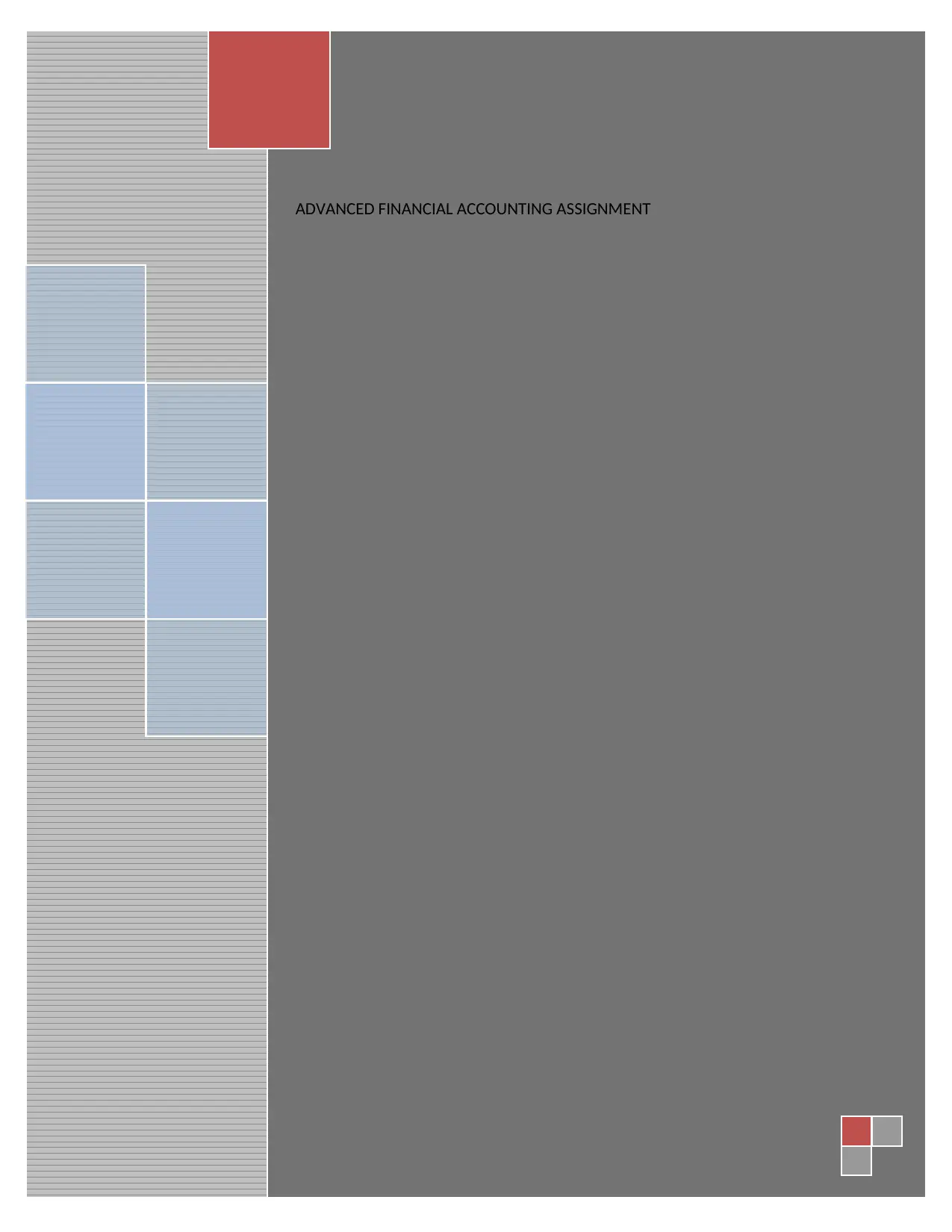
ADVANCED FINANCIAL ACCOUNTING ASSIGNMENT
Paraphrase This Document
Need a fresh take? Get an instant paraphrase of this document with our AI Paraphraser
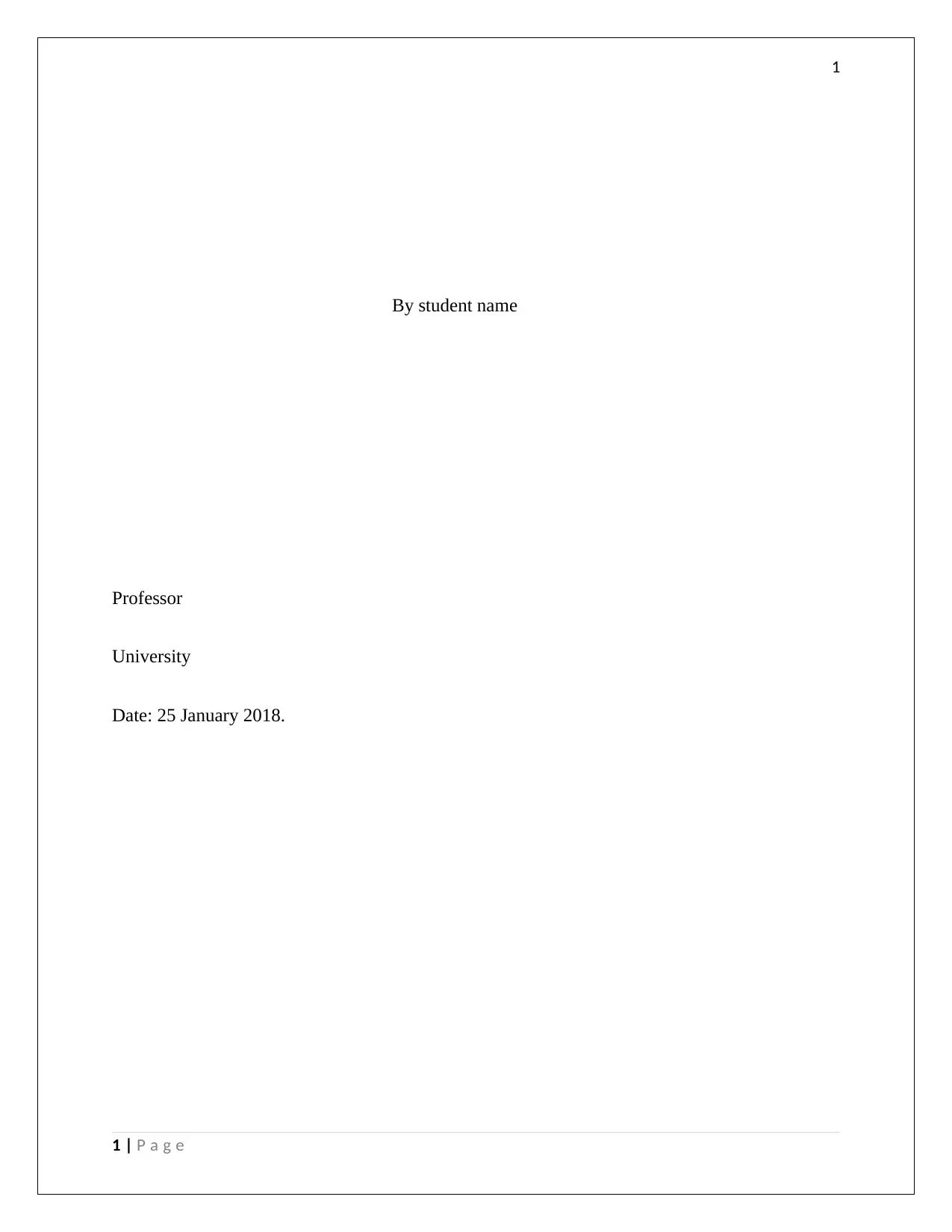
1
By student name
Professor
University
Date: 25 January 2018.
1 | P a g e
By student name
Professor
University
Date: 25 January 2018.
1 | P a g e
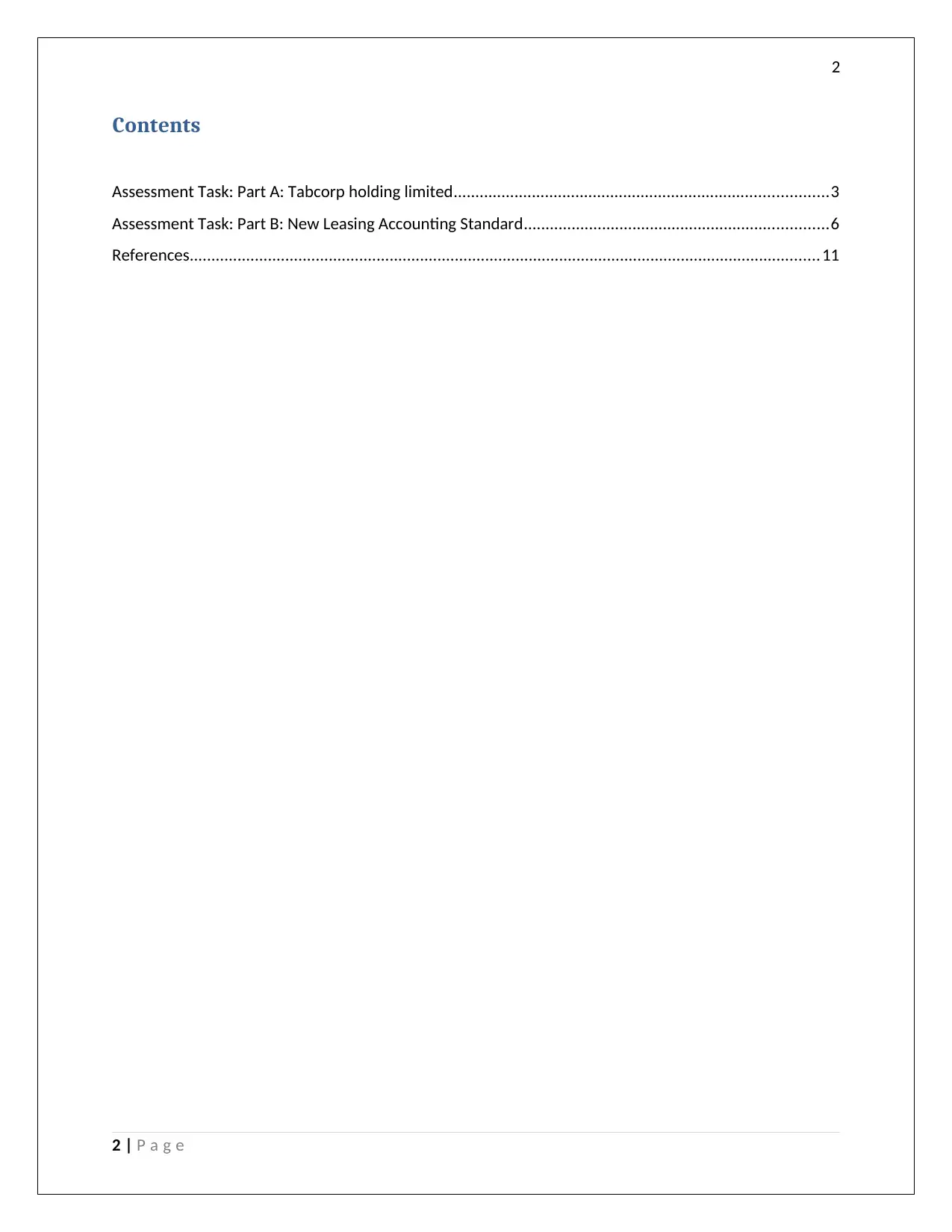
2
Contents
Assessment Task: Part A: Tabcorp holding limited......................................................................................3
Assessment Task: Part B: New Leasing Accounting Standard......................................................................6
References.................................................................................................................................................11
2 | P a g e
Contents
Assessment Task: Part A: Tabcorp holding limited......................................................................................3
Assessment Task: Part B: New Leasing Accounting Standard......................................................................6
References.................................................................................................................................................11
2 | P a g e
⊘ This is a preview!⊘
Do you want full access?
Subscribe today to unlock all pages.

Trusted by 1+ million students worldwide
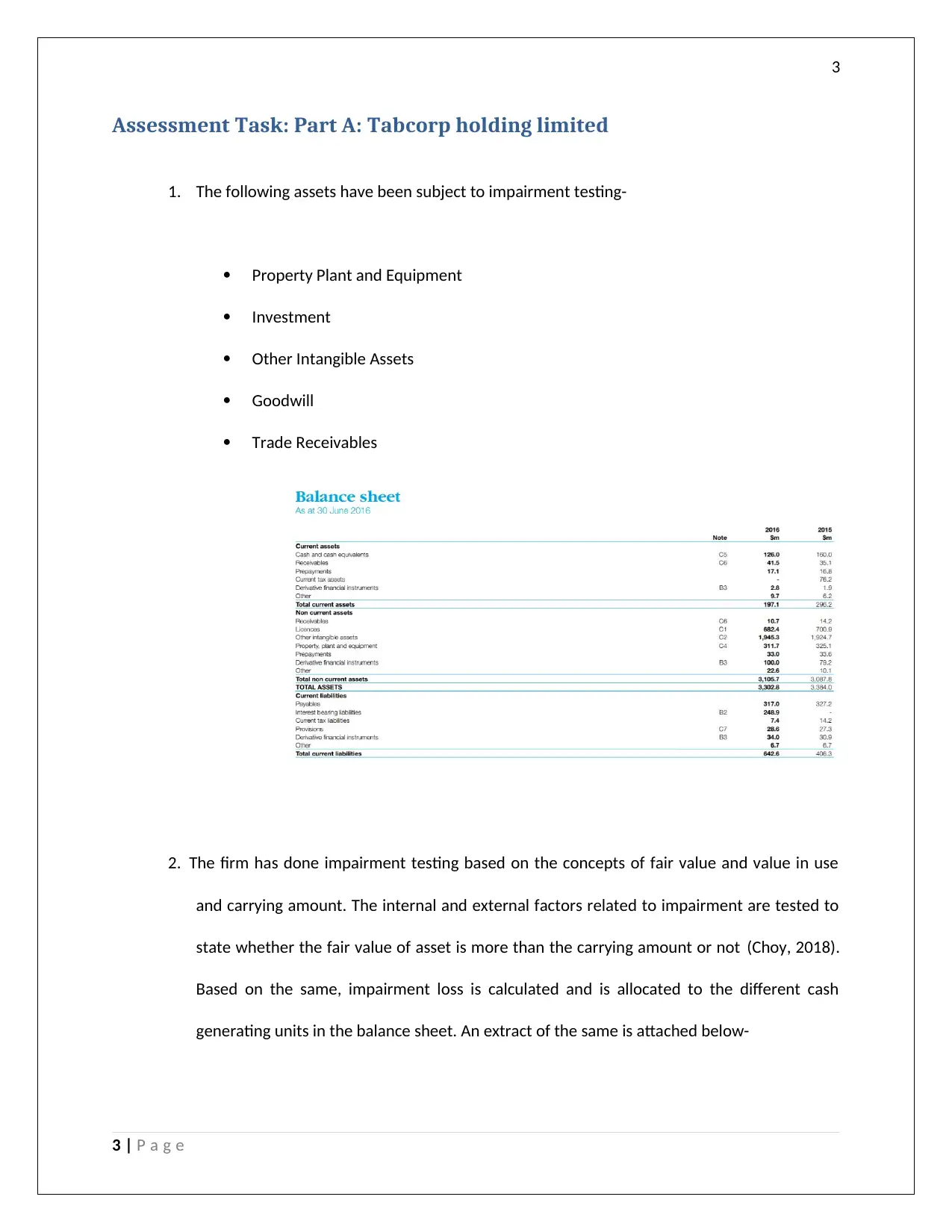
3
Assessment Task: Part A: Tabcorp holding limited
1. The following assets have been subject to impairment testing-
Property Plant and Equipment
Investment
Other Intangible Assets
Goodwill
Trade Receivables
2. The firm has done impairment testing based on the concepts of fair value and value in use
and carrying amount. The internal and external factors related to impairment are tested to
state whether the fair value of asset is more than the carrying amount or not (Choy, 2018).
Based on the same, impairment loss is calculated and is allocated to the different cash
generating units in the balance sheet. An extract of the same is attached below-
3 | P a g e
Assessment Task: Part A: Tabcorp holding limited
1. The following assets have been subject to impairment testing-
Property Plant and Equipment
Investment
Other Intangible Assets
Goodwill
Trade Receivables
2. The firm has done impairment testing based on the concepts of fair value and value in use
and carrying amount. The internal and external factors related to impairment are tested to
state whether the fair value of asset is more than the carrying amount or not (Choy, 2018).
Based on the same, impairment loss is calculated and is allocated to the different cash
generating units in the balance sheet. An extract of the same is attached below-
3 | P a g e
Paraphrase This Document
Need a fresh take? Get an instant paraphrase of this document with our AI Paraphraser
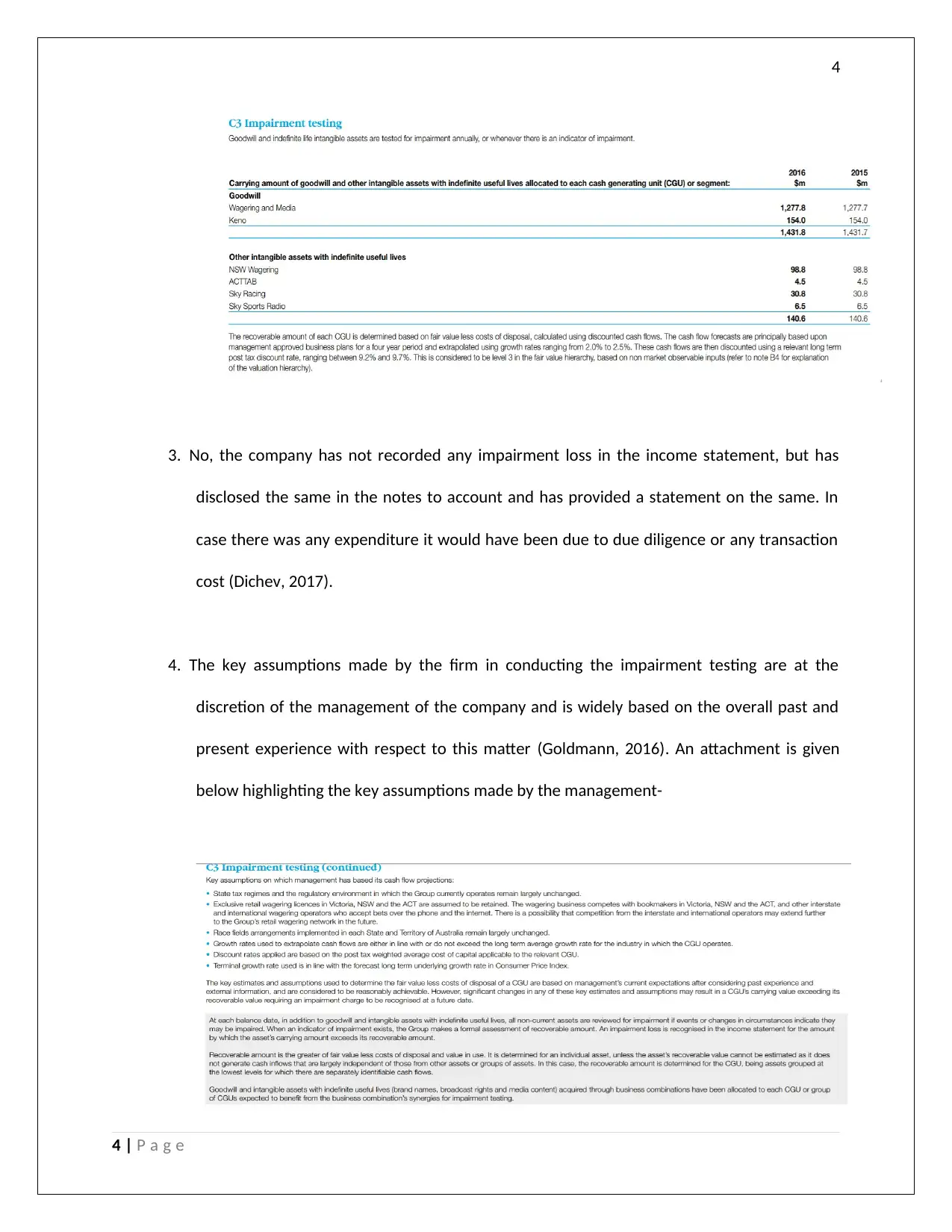
4
3. No, the company has not recorded any impairment loss in the income statement, but has
disclosed the same in the notes to account and has provided a statement on the same. In
case there was any expenditure it would have been due to due diligence or any transaction
cost (Dichev, 2017).
4. The key assumptions made by the firm in conducting the impairment testing are at the
discretion of the management of the company and is widely based on the overall past and
present experience with respect to this matter (Goldmann, 2016). An attachment is given
below highlighting the key assumptions made by the management-
4 | P a g e
3. No, the company has not recorded any impairment loss in the income statement, but has
disclosed the same in the notes to account and has provided a statement on the same. In
case there was any expenditure it would have been due to due diligence or any transaction
cost (Dichev, 2017).
4. The key assumptions made by the firm in conducting the impairment testing are at the
discretion of the management of the company and is widely based on the overall past and
present experience with respect to this matter (Goldmann, 2016). An attachment is given
below highlighting the key assumptions made by the management-
4 | P a g e
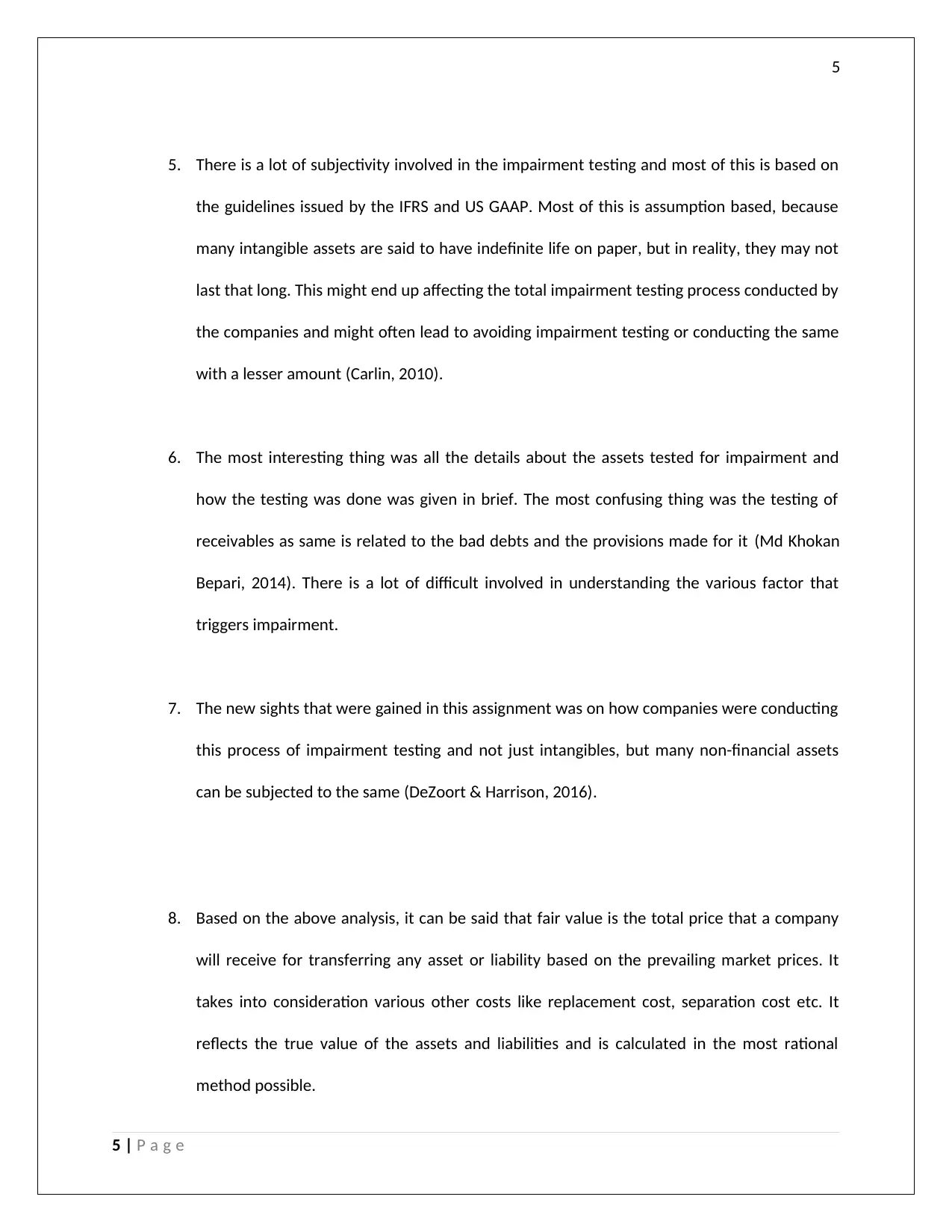
5
5. There is a lot of subjectivity involved in the impairment testing and most of this is based on
the guidelines issued by the IFRS and US GAAP. Most of this is assumption based, because
many intangible assets are said to have indefinite life on paper, but in reality, they may not
last that long. This might end up affecting the total impairment testing process conducted by
the companies and might often lead to avoiding impairment testing or conducting the same
with a lesser amount (Carlin, 2010).
6. The most interesting thing was all the details about the assets tested for impairment and
how the testing was done was given in brief. The most confusing thing was the testing of
receivables as same is related to the bad debts and the provisions made for it (Md Khokan
Bepari, 2014). There is a lot of difficult involved in understanding the various factor that
triggers impairment.
7. The new sights that were gained in this assignment was on how companies were conducting
this process of impairment testing and not just intangibles, but many non-financial assets
can be subjected to the same (DeZoort & Harrison, 2016).
8. Based on the above analysis, it can be said that fair value is the total price that a company
will receive for transferring any asset or liability based on the prevailing market prices. It
takes into consideration various other costs like replacement cost, separation cost etc. It
reflects the true value of the assets and liabilities and is calculated in the most rational
method possible.
5 | P a g e
5. There is a lot of subjectivity involved in the impairment testing and most of this is based on
the guidelines issued by the IFRS and US GAAP. Most of this is assumption based, because
many intangible assets are said to have indefinite life on paper, but in reality, they may not
last that long. This might end up affecting the total impairment testing process conducted by
the companies and might often lead to avoiding impairment testing or conducting the same
with a lesser amount (Carlin, 2010).
6. The most interesting thing was all the details about the assets tested for impairment and
how the testing was done was given in brief. The most confusing thing was the testing of
receivables as same is related to the bad debts and the provisions made for it (Md Khokan
Bepari, 2014). There is a lot of difficult involved in understanding the various factor that
triggers impairment.
7. The new sights that were gained in this assignment was on how companies were conducting
this process of impairment testing and not just intangibles, but many non-financial assets
can be subjected to the same (DeZoort & Harrison, 2016).
8. Based on the above analysis, it can be said that fair value is the total price that a company
will receive for transferring any asset or liability based on the prevailing market prices. It
takes into consideration various other costs like replacement cost, separation cost etc. It
reflects the true value of the assets and liabilities and is calculated in the most rational
method possible.
5 | P a g e
⊘ This is a preview!⊘
Do you want full access?
Subscribe today to unlock all pages.

Trusted by 1+ million students worldwide
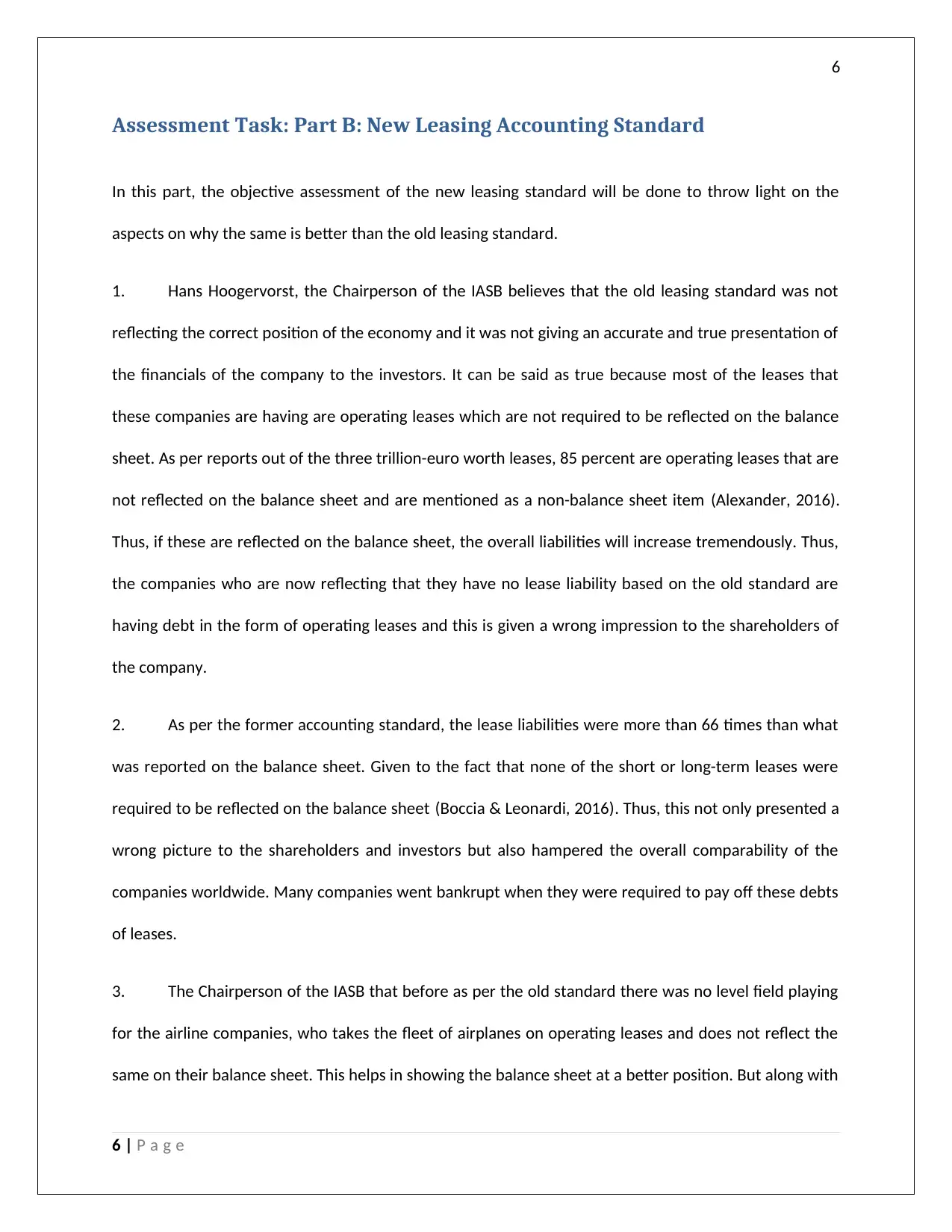
6
Assessment Task: Part B: New Leasing Accounting Standard
In this part, the objective assessment of the new leasing standard will be done to throw light on the
aspects on why the same is better than the old leasing standard.
1. Hans Hoogervorst, the Chairperson of the IASB believes that the old leasing standard was not
reflecting the correct position of the economy and it was not giving an accurate and true presentation of
the financials of the company to the investors. It can be said as true because most of the leases that
these companies are having are operating leases which are not required to be reflected on the balance
sheet. As per reports out of the three trillion-euro worth leases, 85 percent are operating leases that are
not reflected on the balance sheet and are mentioned as a non-balance sheet item (Alexander, 2016).
Thus, if these are reflected on the balance sheet, the overall liabilities will increase tremendously. Thus,
the companies who are now reflecting that they have no lease liability based on the old standard are
having debt in the form of operating leases and this is given a wrong impression to the shareholders of
the company.
2. As per the former accounting standard, the lease liabilities were more than 66 times than what
was reported on the balance sheet. Given to the fact that none of the short or long-term leases were
required to be reflected on the balance sheet (Boccia & Leonardi, 2016). Thus, this not only presented a
wrong picture to the shareholders and investors but also hampered the overall comparability of the
companies worldwide. Many companies went bankrupt when they were required to pay off these debts
of leases.
3. The Chairperson of the IASB that before as per the old standard there was no level field playing
for the airline companies, who takes the fleet of airplanes on operating leases and does not reflect the
same on their balance sheet. This helps in showing the balance sheet at a better position. But along with
6 | P a g e
Assessment Task: Part B: New Leasing Accounting Standard
In this part, the objective assessment of the new leasing standard will be done to throw light on the
aspects on why the same is better than the old leasing standard.
1. Hans Hoogervorst, the Chairperson of the IASB believes that the old leasing standard was not
reflecting the correct position of the economy and it was not giving an accurate and true presentation of
the financials of the company to the investors. It can be said as true because most of the leases that
these companies are having are operating leases which are not required to be reflected on the balance
sheet. As per reports out of the three trillion-euro worth leases, 85 percent are operating leases that are
not reflected on the balance sheet and are mentioned as a non-balance sheet item (Alexander, 2016).
Thus, if these are reflected on the balance sheet, the overall liabilities will increase tremendously. Thus,
the companies who are now reflecting that they have no lease liability based on the old standard are
having debt in the form of operating leases and this is given a wrong impression to the shareholders of
the company.
2. As per the former accounting standard, the lease liabilities were more than 66 times than what
was reported on the balance sheet. Given to the fact that none of the short or long-term leases were
required to be reflected on the balance sheet (Boccia & Leonardi, 2016). Thus, this not only presented a
wrong picture to the shareholders and investors but also hampered the overall comparability of the
companies worldwide. Many companies went bankrupt when they were required to pay off these debts
of leases.
3. The Chairperson of the IASB that before as per the old standard there was no level field playing
for the airline companies, who takes the fleet of airplanes on operating leases and does not reflect the
same on their balance sheet. This helps in showing the balance sheet at a better position. But along with
6 | P a g e
Paraphrase This Document
Need a fresh take? Get an instant paraphrase of this document with our AI Paraphraser
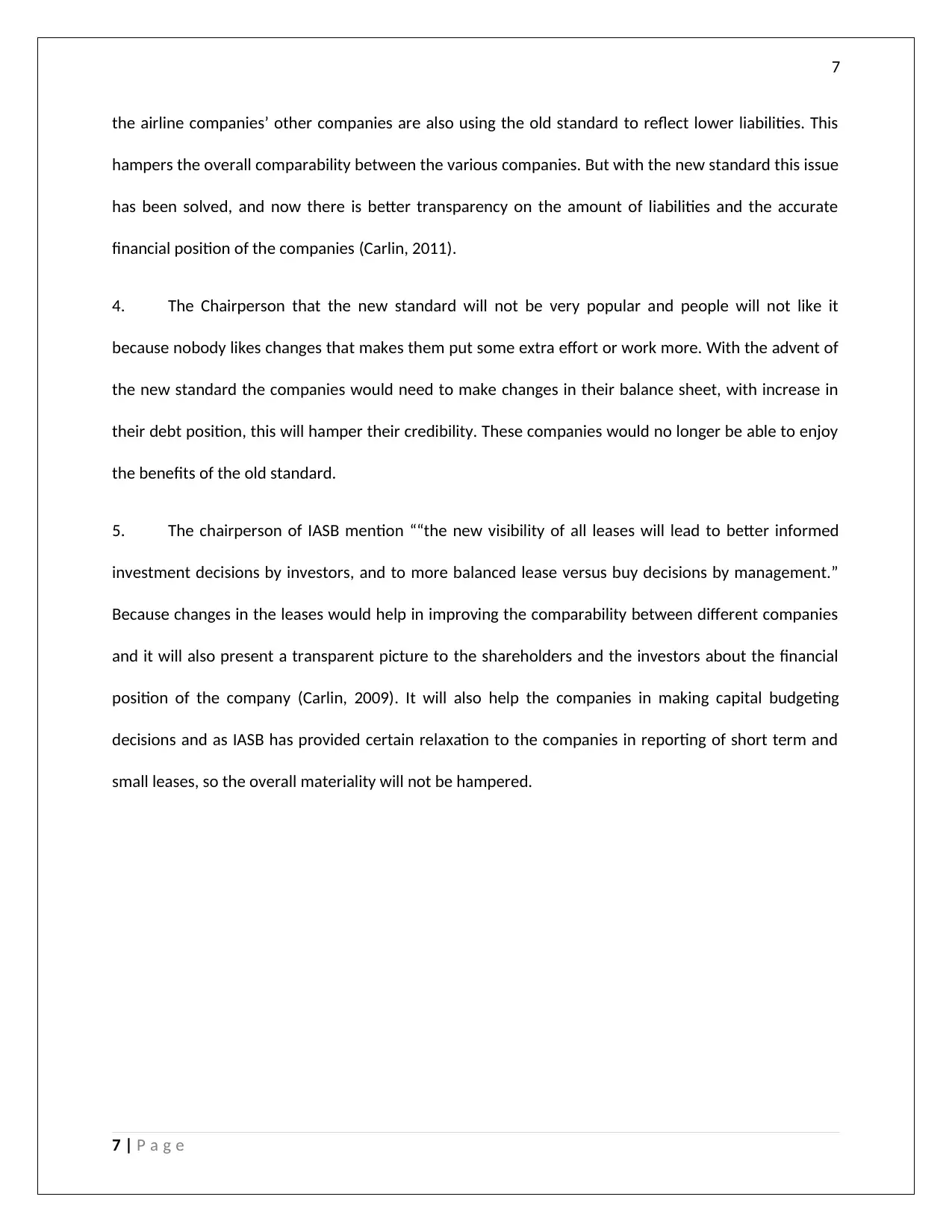
7
the airline companies’ other companies are also using the old standard to reflect lower liabilities. This
hampers the overall comparability between the various companies. But with the new standard this issue
has been solved, and now there is better transparency on the amount of liabilities and the accurate
financial position of the companies (Carlin, 2011).
4. The Chairperson that the new standard will not be very popular and people will not like it
because nobody likes changes that makes them put some extra effort or work more. With the advent of
the new standard the companies would need to make changes in their balance sheet, with increase in
their debt position, this will hamper their credibility. These companies would no longer be able to enjoy
the benefits of the old standard.
5. The chairperson of IASB mention ““the new visibility of all leases will lead to better informed
investment decisions by investors, and to more balanced lease versus buy decisions by management.”
Because changes in the leases would help in improving the comparability between different companies
and it will also present a transparent picture to the shareholders and the investors about the financial
position of the company (Carlin, 2009). It will also help the companies in making capital budgeting
decisions and as IASB has provided certain relaxation to the companies in reporting of short term and
small leases, so the overall materiality will not be hampered.
7 | P a g e
the airline companies’ other companies are also using the old standard to reflect lower liabilities. This
hampers the overall comparability between the various companies. But with the new standard this issue
has been solved, and now there is better transparency on the amount of liabilities and the accurate
financial position of the companies (Carlin, 2011).
4. The Chairperson that the new standard will not be very popular and people will not like it
because nobody likes changes that makes them put some extra effort or work more. With the advent of
the new standard the companies would need to make changes in their balance sheet, with increase in
their debt position, this will hamper their credibility. These companies would no longer be able to enjoy
the benefits of the old standard.
5. The chairperson of IASB mention ““the new visibility of all leases will lead to better informed
investment decisions by investors, and to more balanced lease versus buy decisions by management.”
Because changes in the leases would help in improving the comparability between different companies
and it will also present a transparent picture to the shareholders and the investors about the financial
position of the company (Carlin, 2009). It will also help the companies in making capital budgeting
decisions and as IASB has provided certain relaxation to the companies in reporting of short term and
small leases, so the overall materiality will not be hampered.
7 | P a g e
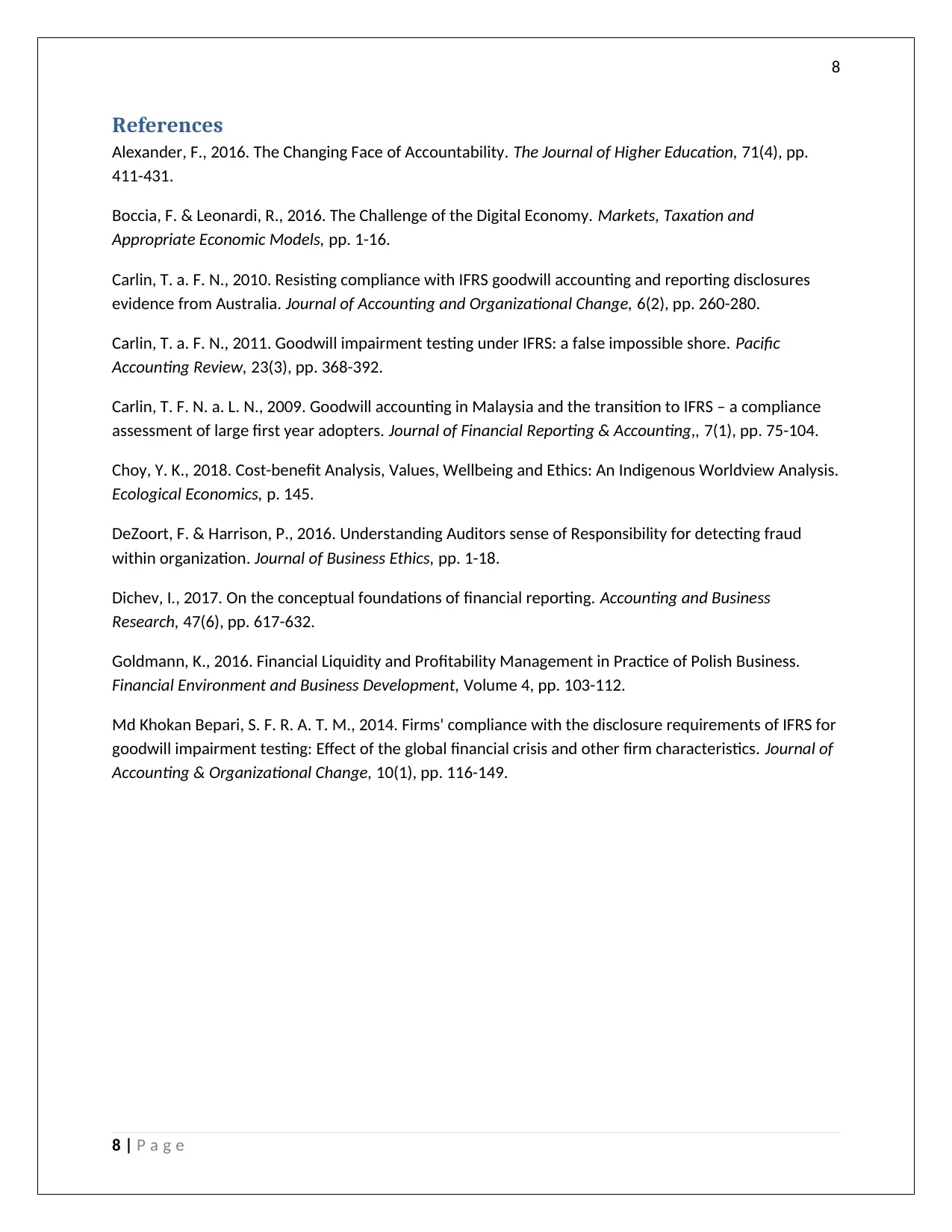
8
References
Alexander, F., 2016. The Changing Face of Accountability. The Journal of Higher Education, 71(4), pp.
411-431.
Boccia, F. & Leonardi, R., 2016. The Challenge of the Digital Economy. Markets, Taxation and
Appropriate Economic Models, pp. 1-16.
Carlin, T. a. F. N., 2010. Resisting compliance with IFRS goodwill accounting and reporting disclosures
evidence from Australia. Journal of Accounting and Organizational Change, 6(2), pp. 260-280.
Carlin, T. a. F. N., 2011. Goodwill impairment testing under IFRS: a false impossible shore. Pacific
Accounting Review, 23(3), pp. 368-392.
Carlin, T. F. N. a. L. N., 2009. Goodwill accounting in Malaysia and the transition to IFRS – a compliance
assessment of large first year adopters. Journal of Financial Reporting & Accounting,, 7(1), pp. 75-104.
Choy, Y. K., 2018. Cost-benefit Analysis, Values, Wellbeing and Ethics: An Indigenous Worldview Analysis.
Ecological Economics, p. 145.
DeZoort, F. & Harrison, P., 2016. Understanding Auditors sense of Responsibility for detecting fraud
within organization. Journal of Business Ethics, pp. 1-18.
Dichev, I., 2017. On the conceptual foundations of financial reporting. Accounting and Business
Research, 47(6), pp. 617-632.
Goldmann, K., 2016. Financial Liquidity and Profitability Management in Practice of Polish Business.
Financial Environment and Business Development, Volume 4, pp. 103-112.
Md Khokan Bepari, S. F. R. A. T. M., 2014. Firms' compliance with the disclosure requirements of IFRS for
goodwill impairment testing: Effect of the global financial crisis and other firm characteristics. Journal of
Accounting & Organizational Change, 10(1), pp. 116-149.
8 | P a g e
References
Alexander, F., 2016. The Changing Face of Accountability. The Journal of Higher Education, 71(4), pp.
411-431.
Boccia, F. & Leonardi, R., 2016. The Challenge of the Digital Economy. Markets, Taxation and
Appropriate Economic Models, pp. 1-16.
Carlin, T. a. F. N., 2010. Resisting compliance with IFRS goodwill accounting and reporting disclosures
evidence from Australia. Journal of Accounting and Organizational Change, 6(2), pp. 260-280.
Carlin, T. a. F. N., 2011. Goodwill impairment testing under IFRS: a false impossible shore. Pacific
Accounting Review, 23(3), pp. 368-392.
Carlin, T. F. N. a. L. N., 2009. Goodwill accounting in Malaysia and the transition to IFRS – a compliance
assessment of large first year adopters. Journal of Financial Reporting & Accounting,, 7(1), pp. 75-104.
Choy, Y. K., 2018. Cost-benefit Analysis, Values, Wellbeing and Ethics: An Indigenous Worldview Analysis.
Ecological Economics, p. 145.
DeZoort, F. & Harrison, P., 2016. Understanding Auditors sense of Responsibility for detecting fraud
within organization. Journal of Business Ethics, pp. 1-18.
Dichev, I., 2017. On the conceptual foundations of financial reporting. Accounting and Business
Research, 47(6), pp. 617-632.
Goldmann, K., 2016. Financial Liquidity and Profitability Management in Practice of Polish Business.
Financial Environment and Business Development, Volume 4, pp. 103-112.
Md Khokan Bepari, S. F. R. A. T. M., 2014. Firms' compliance with the disclosure requirements of IFRS for
goodwill impairment testing: Effect of the global financial crisis and other firm characteristics. Journal of
Accounting & Organizational Change, 10(1), pp. 116-149.
8 | P a g e
⊘ This is a preview!⊘
Do you want full access?
Subscribe today to unlock all pages.

Trusted by 1+ million students worldwide
1 out of 9
Related Documents
Your All-in-One AI-Powered Toolkit for Academic Success.
+13062052269
info@desklib.com
Available 24*7 on WhatsApp / Email
![[object Object]](/_next/static/media/star-bottom.7253800d.svg)
Unlock your academic potential
Copyright © 2020–2025 A2Z Services. All Rights Reserved. Developed and managed by ZUCOL.





